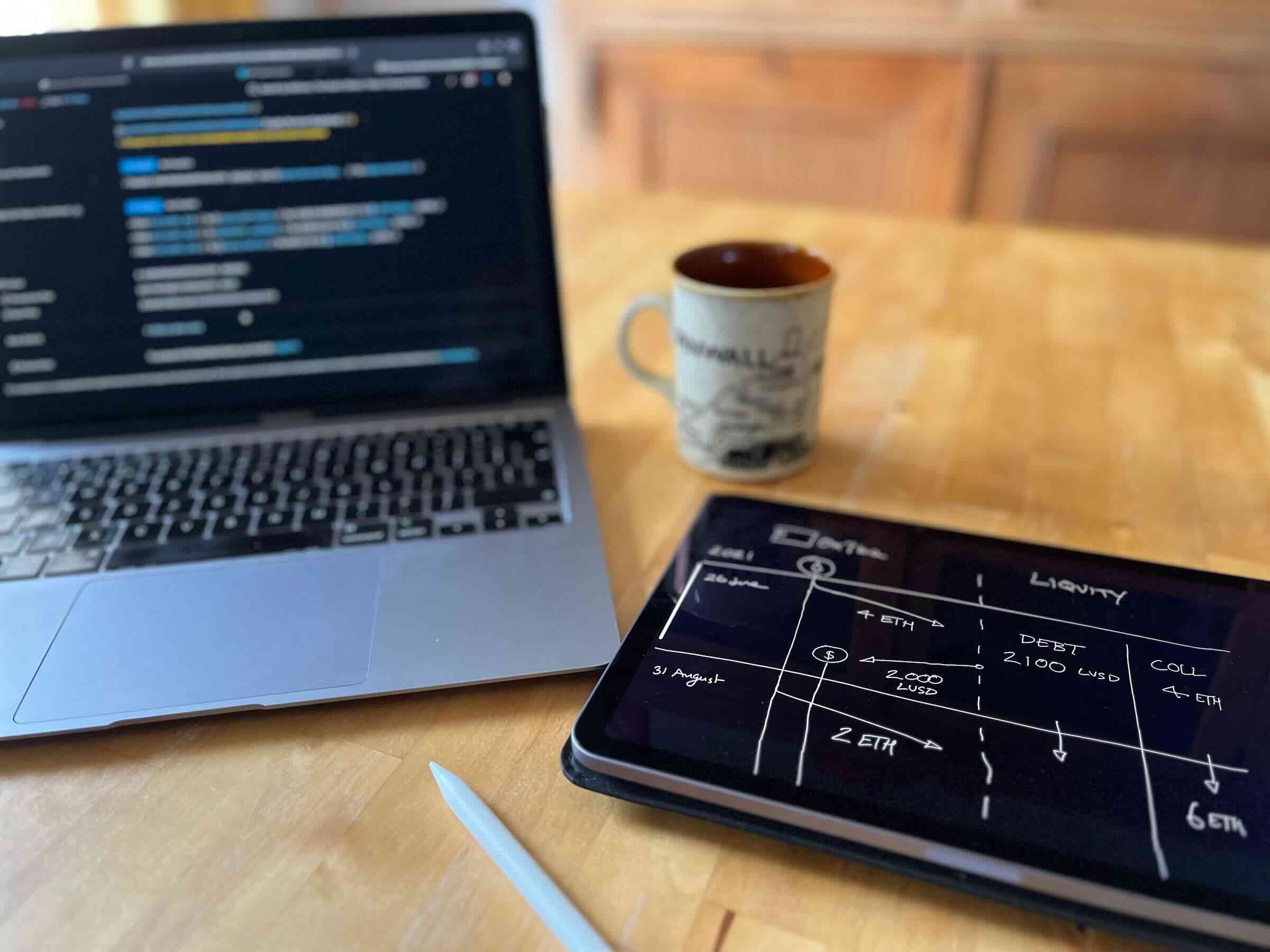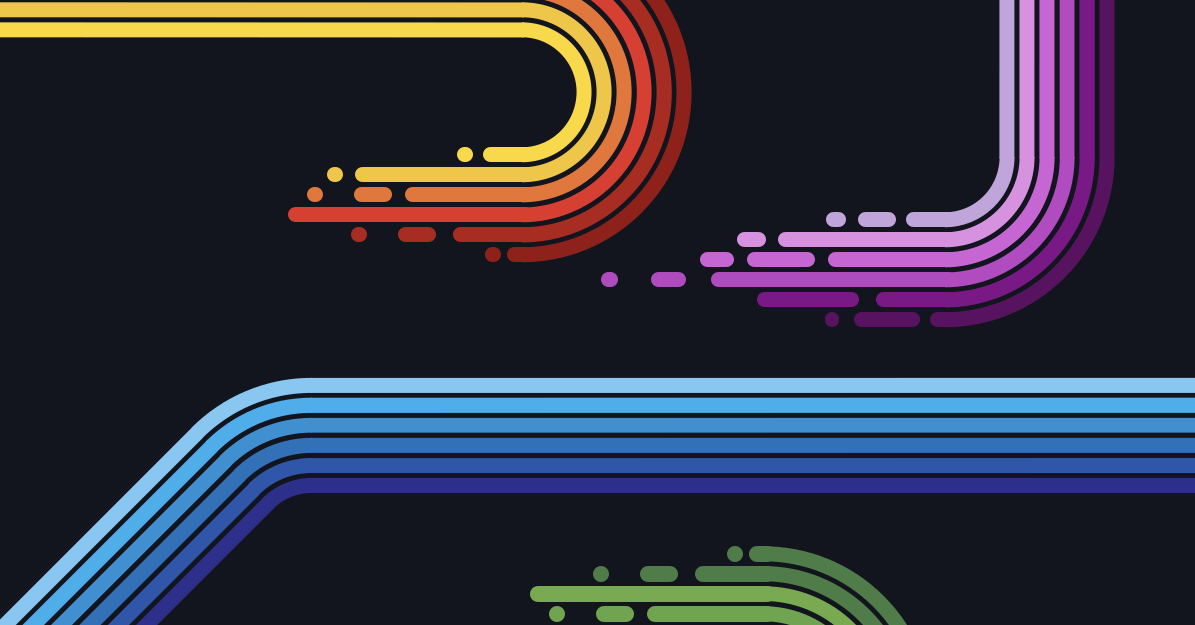Rails began with my own struggle to untangle my on-chain activity. That confusion — and a desire to contribute meaningfully to the blockchain space — led me to build Rails, a web app designed to make DeFi protocols clear and accessible for everyone.
Discovering digital truth (2018–2021)
In 2018, Ethereum’s promise of programmable property rights — digital truth — captured my imagination. At a time when it felt like we were surrendering our digital selves to a handful of big tech companies, the idea that blockchains would enable an individual's control over their data excited me.
Yet up to 2021, I mostly watched from the sidelines — fascinated by the innovation and the drama, but wary of the scams, hacks and the complexity that made using the technology feel risky.
The kitchen table blueprint (2021)
By mid-2021, curiosity won out. I opened a position on Liquity — a DeFi lending protocol that issues a stablecoin (LUSD) as a debt asset and relies on sophisticated on-chain mechanics to hold its peg to the dollar.
As someone who’s dyslexic and not naturally comfortable with numbers, understanding how it all worked was a challenge. Given that the blockchain is a public ledger, it seemed like it should be straightforward. I found myself sketching lines between the protocol and my wallet across a timeline — a map began to take shape. That map helped me decode my transactions and see clearly what was happening. It became the blueprint for Rails.

Seeing the Rails (2021–2022)
I moved from sketches to HTML and CSS — at first, just for fun. Being a self-employed graphic designer with a background in medical illustration, I'd spent years synthesizing complex information into simple visualisations. The more I explored, the clearer it became that DeFi was missing a visual, plain-language layer to bridge the gap between users and protocols — one built on progressive disclosure, where clarity comes from revealing detail step by step — giving users a simple overview of their activity before guiding them into the deeper mechanics of an application.
Fueled by that vision, I began mocking up prototypes for more sophisticated portfolio explorers — tools that could traverse multiple blockchains, decentralised applications, and off-chain finance.

I shared those early mockups with a former boss — now the chairman of Elliptic, a blockchain forensics firm. His enthusiasm gave me the confidence to make Rails my mission. He introduced me to Elliptic’s CEO, who recommended I plug into the vibrant crypto community.
I applied to attend the ETHGlobal hackathon, ETHAmsterdam 2022 — that weekend strengthened my belief that I was on to something. I joined a team designing a cutting-edge soulbound NFT project. I met Liquity’s inventor, shared my work with others (including Justin Bram, the YouTube educator whose video had first taught me how to use Liquity), and received genuine enthusiasm for what I was building. I was excited for what could come next.
Fired up by that energy, I headed to ETHNewYork 2022. I set out to find a developer to team up with. My hack was a visualiser for a Superfluid app, set on a Rails-like platform; it wasn't the grand project idea but opened my mind to a more niche approach and won me a pool prize — I also landed some design work on a Superfluid project visualising streaming quadratic funding, gaining valuable experience and connections but falling short of finding a collaborator.
Getting real (2022–2023)
I enlisted a developer friend and he played with building a prototype that could capture every transaction on Ethereum mainnet — building an explorer that turned wallet transactions into simple, map-like visualisations. It was beautiful but proved that taking this approach was going to have huge overheads.
By this point, Rails was consuming most of my time. I was turning down paid work to focus on it, but with a family and bills to pay, the pressure for it to materialise into something sustainable was mounting.
In late 2023, I formalised my vision in a grant proposal to the Ethereum Foundation — describing Rails as “route maps for Ethereum”, a public good to help users understand the network. Though the application was unsuccessful, the process clarified the mission: start small, build for one protocol, and prove the value of making DeFi visible.
I started where it all began: Liquity. With no choice but to work solo, I built and rebuilt Liquity V1 explorers, learning the protocol’s transaction patterns inside out.
For Rails to become a true visual language, it had to adapt beyond Liquity. I took this streamlined approach to ETHIstanbul 2023 (for CowSwap) and later to ETHLondon 2024 (for Morpho), applying a protocol-first Rails design language.

The response was positive, but I knew I needed something more concrete — a functioning prototype using real events. That was when I began, in earnest, to take my role as a developer more seriously. If Rails was going to work, it was the only way forward. Stepping into coding from design proved to be an essential step in my own development.
Finding market fit (2024–2025)
In early 2024, I began chatting with the Liquity team, sharing updates on Rails and exchanging ideas about how it might help their users. By the time we met in person at ETHCC 2024, they were already familiar with my work. When I introduced myself to Michael, Liquity’s CEO, he was enthusiastic about the project and encouraged me to keep developing it — suggesting that if I could turn it into something genuinely useful, I should apply for a grant.
After the conference, we kept in touch online, and I threw myself into building a more sophisticated explorer — one that could demonstrate the value of making protocol activity truly legible. Still working solo and without a developer, I felt I had to prove I could build a robust, production-ready app on my own.
Thanks to progress in AI tools, that goal became more achievable. I began producing work I felt confident enough to share publicly and, with Michael’s encouragement, formally applied for a grant to help push the build over the line.
At ETHCC 2025, I showed Michael the latest version — a working Liquity explorer that reflected everything I’d been building toward. The feedback was positive, and for the first time, it felt like Rails had moved from an idea to a real, living product. It was a milestone moment after years of iteration.
At the same event, through Victor from Lens, I met Slava (@slvdev) — a developer who immediately understood the vision behind Rails. With Liquity’s grant contribution on the horizon, we began collaborating, turning years of solo work into a partnership while continuing to self-fund the remaining development.
Team Rails (2025)
By the time Slava joined, Rails had gone from sketches to a working application — but it needed an engineer’s discipline to reach production quality. Slava's technical depth and rigour have brought the stability and precision Rails needs to become real infrastructure. For the first time, we can focus on shaping the experience and expanding to new protocols — knowing the foundation beneath it is solid.
Together, we’ve built a base that truly lives up to the original vision: a platform ready to grow with DeFi — and let's be BOLD, to help grow DeFi itself.
Rails is the beginning of an ecosystem — a place where complex financial protocols can finally be made clear, human, and usable. The mission hasn’t changed since those first kitchen table sketches.
We launched the new rails.finance in November 2025.

What comes next (2025–2026)
Rails is live (in Beta) with full Liquity V2 Trove coverage, built on infrastructure meant for the long haul. We’re self-funding beyond the Liquity grant while lining up new partners and grants to keep this public-good mission alive — and growing.
Connect with us:
Try Rails: rails.finance
Follow: @rails_finance
Collaborate: If you’re a protocol team or grant provider, we’d love to connect.
If you’d like to follow our journey or explore integrations, reach out.
Story by Miles Essex (@milesessex), designer of Rails.
